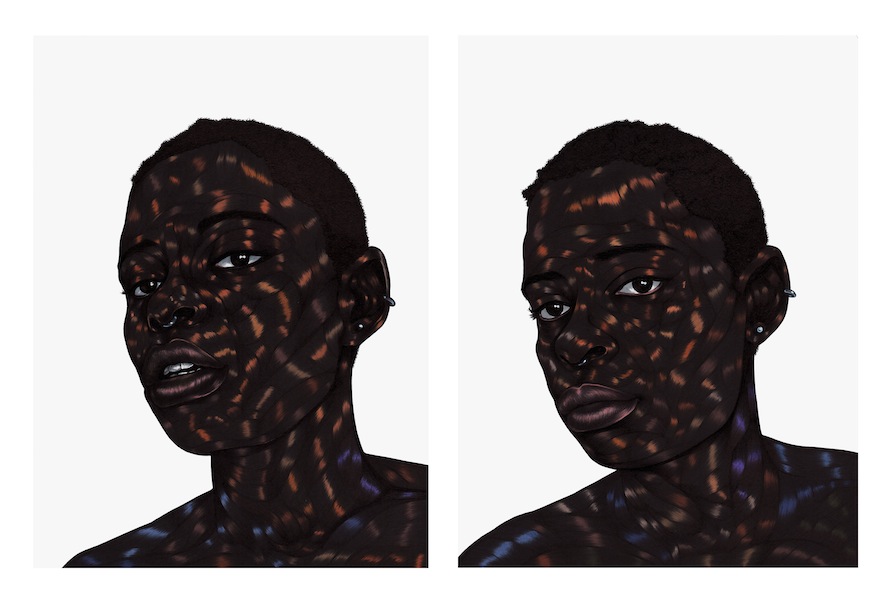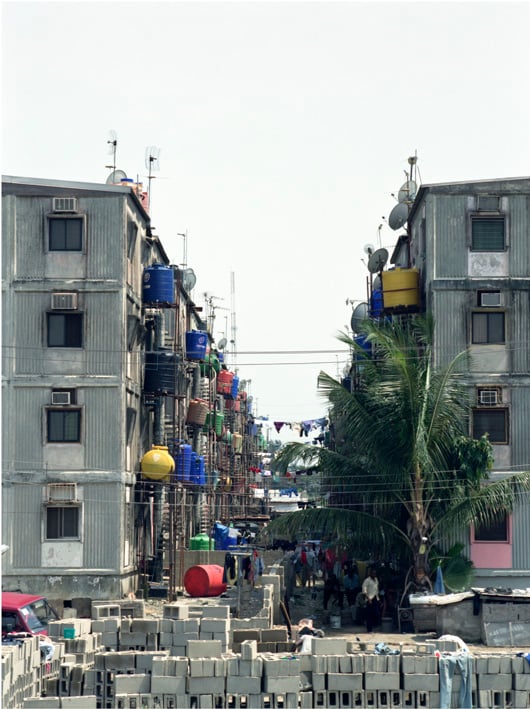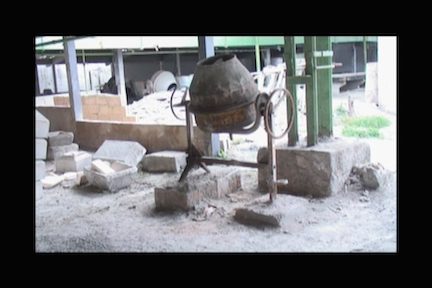
© » KADIST
Maria Fernanda Plata
Unraveling, or “unweaving” sections of fabric, Maria Fernanda Plata arrived at delicate and tenuous-looking forms, both ghostly and gentle. Her careful meditations in fabric reflect Plata’s ongoing interest in the relationship between people and their environments, in fragility, systems, and destruction.

© » KADIST
Hao Liang
Eight Views of Xiao and Xiang is a series of landscapes in the Xiaoxiang region in the modern day Hunan Province, China, and was a popular subject of poems, drawings and paintings during the Song Dynasty (960–1279). Liang follows tradition by interpreting the historical subjects by classical Chinese artists including Dong Yuan (934–962 AD), Mu Xi (died in 1281 AD), Wen Weiming (1470–1559 AD). This reinterpretation represents the meeting point of the Xiang River and the Dongting Lake.

© » KADIST
Suzanne Treister
HFT The Gardner by Suzanne Treister is a large-scale project that comprises drawings and computer works by fictional character Hillel Fischer Traumberg. HFT is an algorithmic High-Frequency Trader based in London, who experiences a hallucinogenic episode that triggers a journey into the exploration of psychoactive plants. In a nerd-like discovery of Discovering Hebrew, numerology, botany, and shamanic divination and healing, HFT becomes an ‘outsider artist’ whose works are collected by oligarchs, bankers, and museums, much like in the mainstream art world.

© » KADIST
Lola Gonzàlez
In Summer Camp , Lola Gonzàlez filmed a group of friends at the home of her parents in the department of Charente (France) in the process of transforming the house into a training camp. They are doing exercises with the furniture as if they were training to fight against something yet to happen. Gonzàlez ’s films persistently evoke the same fear of an external threat, one which is never explained but which can be placed in relation with the current political situation and social tension.

© » KADIST
Gabriella and Silvana Mangano
There is no there by Gabriella and Silvana Mangano is a black and white looped video with sound, in conjunction with a live performance. The work is inspired by the Blue Blouse, a political propaganda theater movement which spread across the Soviet Union in the mid-1920s. More specifically, the work takes the form of ‘Living Newspapers’, which were performances based on topical news events.

© » KADIST
Sara Cwynar
Drawing & Print (Drawing & Print)
Sara Cwynar’s composite photographs of found objects and images court feelings of time passing. Using studio sets, collage, and re-photography, she produces intricate tableaux that draw from magazine advertisements, postcards, or catalogs. Cwynar is interested in how design and popular images work on our psyches, in how their visual strategies infiltrate our consciousness.
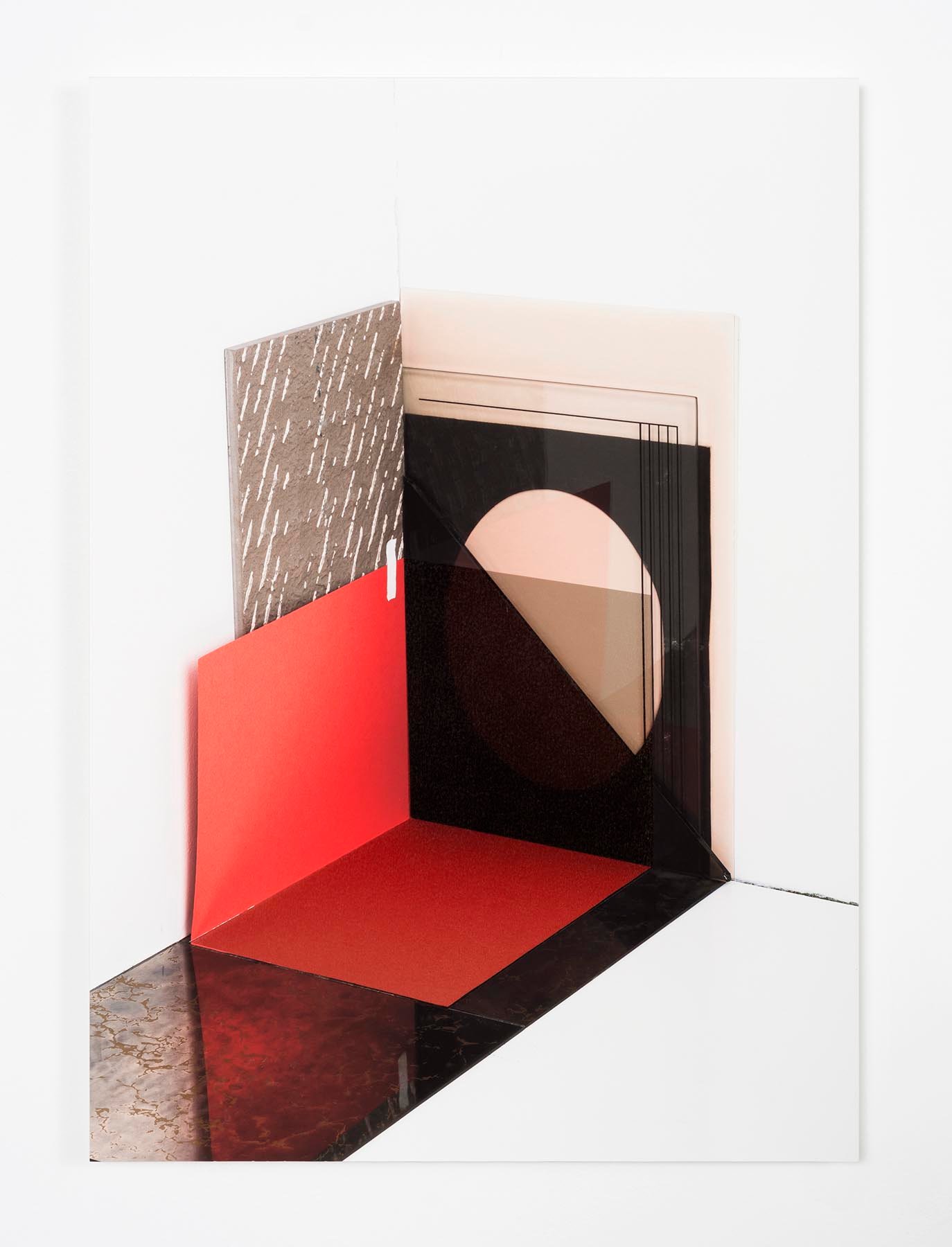
© » KADIST
Phillip Maisel
While his works can function as abstract, they are very much rooted in physicality and the possibilities that are inherent in the materials themselves. Elements used in various stages of photographic processes (color filters, glassine, and prints themselves) are integrated back into the artwork either as part of the sculpture or as collage elements that are later added to the print. In some of the works, Maisel cuts into the prints themselves.

© » KADIST
Adriana Martínez
Her 2015 work Orión is a black flag-like cloth with glow-in-the-dark symbols embroidered in the shape of the constellation. In the place of stars, Martínez has substituted the logos of international corporations and entities that use stars as their symbol; celestial navigation commanded by the logic of international corporations. Easily spotted is the smiling face of the Carl’s Jr. / Hardee’s logo, the three-pronged Mercedes-Benz emblem, Walmart’s six-pointed asterisk, and the starry cluster of the Subaru shield.

© » KADIST
Otobong Nkanga
Tsumeb Fragments was produced for the exhibition at Kadist, “Comot Your Eyes Make I Borrow You Mine” in 2015. In Spring 2015, Nkanga travelled to Namibia, making her way along an almost entirely defunct railway line from Swakopmund to Tsumeb. The artist was intent on reaching The Green Hill in Tsumeb, an area renowned for its minerals, crystals and copper deposits.

© » KADIST
siren eun young jung
Drawing & Print (Drawing & Print)
Deferral Archive is one of the archival extensions of siren eun young jung’s Yeoseong Gukgeuk Project (2008-), a decade-long ethnographic research project into the diminishing genre of Korean traditional theater known as Yeoseong Gukgeuk . The genre, which was popular in the 1950s-60s, has since been forgotten, without ever being established as either a traditional or modern form of Korean theater. The most distinctive formal trait of Yeoseong Gukgeuk is that the theater performers are exclusively women.

© » KADIST
Yuji Agematsu
Each day, Yuji Agematsu smokes a pack of cigarettes and wanders the streets of New York City looking for trash. Needless to say, he finds it everywhere: bottle caps, gummed hair, translucent miscellany, sick feathers, hot pink plastics, unknown, and more. The varied bits are then constellated by the artist in cellophane cigarette wrappers—modest vitrines for his steady collecting habit.

© » KADIST
Candice Lin
For the work Wigan Pit-Brow Women: Intersections with the Caribbean (mobile) , Candice Lin studied English Victorian Arthur Munby’s racialized and masculinized drawings of working-class white female miners. Specifically, Lin’s work critically addresses Munby’s observations about the laborers’ femininity that was more concerned with the modesty of the women, than that they toiled in life-threatening situations. “Pit brow women” or “pit brow lasses” were female surface laborers at British collieries.
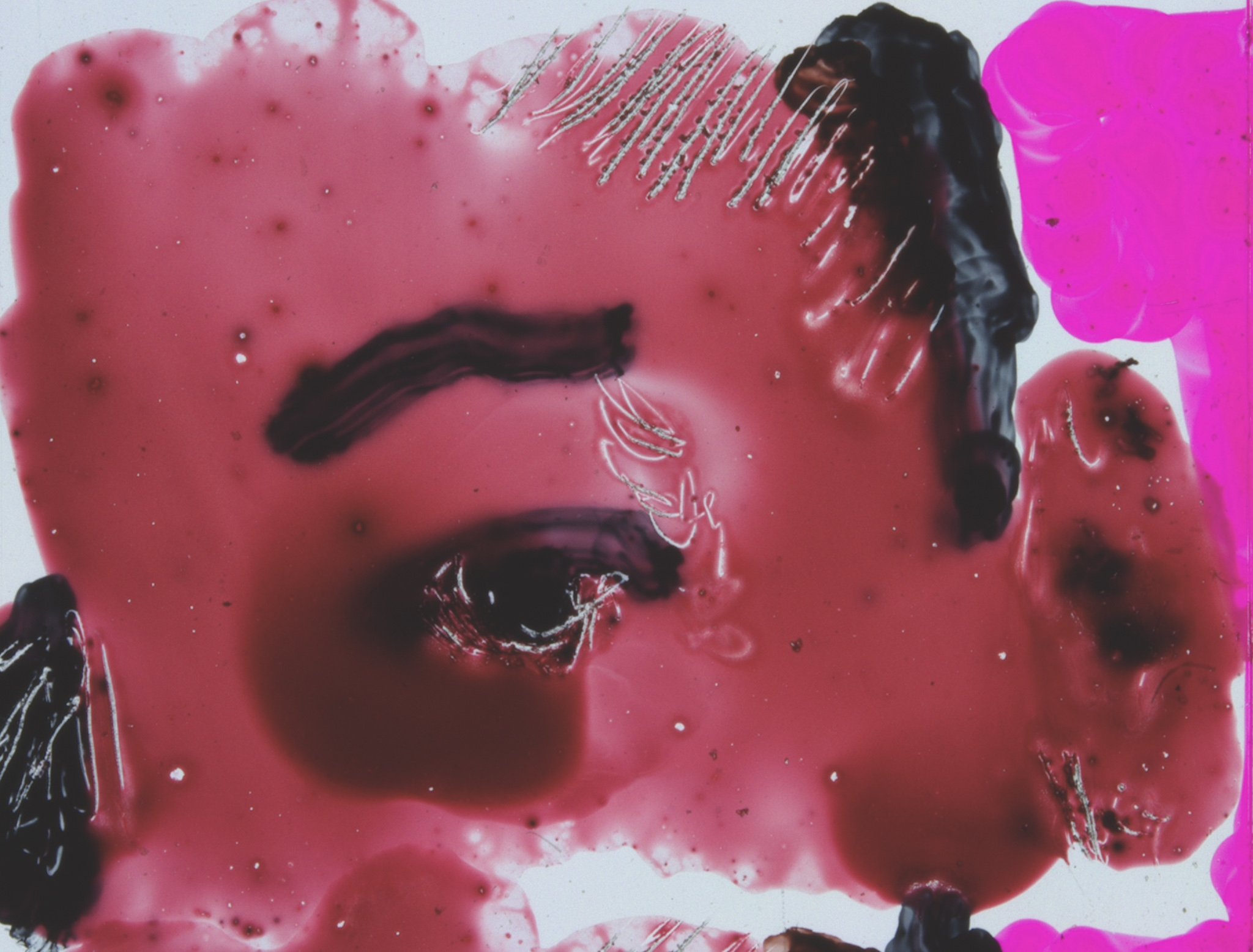
© » KADIST
Diego Marcon
The video animation Falling Head 2 , hand-painted by Diego Marcon in 2015, consists of a close-up of a head caught on the threshold between sleep and wakefulness or maybe from wakefulness to sleep. The film is projected as a ten-second loop where the first and last frames coincide. Working mainly in video and film, Marcon is familiar with the consequences of eyestrain.

© » KADIST
Mariana Castillo Deball
Taking archaeology as her departure point to examine the trajectories of replicated and displaced objects, “Who will measure the space, who will tell me the time?” was produced in Oaxaca for her exhibition of the same title at the Contemporary Museum of Oaxaca (MACO) in 2015. The sculpture, employing the technique of traditional Atzompa pottery originating from Oaxaca, Mexico, is an examination of the way in which archaeological heritage is remembered in the earthenware made by Atzompa potters today. Accompanied by the publication ‘Ixiptla Vol.

© » KADIST
Kaoru Arima
Arima’s free brushstrokes gesture towards traditions in Expressionist painting, and Ticket could be seen as an attempt at “pure painting” in which the aesthetics of the medium supersede content. But if his portraits resist social commentary, they nonetheless challenge conventional standards of beauty through a decided embrace of decayed forms and colors. Inspired by underground creative cultures, his paintings have the slipshod spontaneity of graffiti and other types of street art.

© » KADIST
Michelle Handelman
Michelle Handelman’s video work Irma Vep, The Last Breath takes its inspiration from Musidora, a famous French silent film actress, and a character she played called Irma Vep, from the film Les Vampires (1915), directed by Louis Feuillade. The work uses these characters as metaphors to highlight the lives of those who live in the shadows—or feel like they do—and the anxiety they experience as marginalized figures. Musidora was a 20th-century feminist, who was known not only for acting in movies, but also for directing her own plays and films, and having secret affairs with Colette and other famous people of the time.

© » KADIST
Taloi Havini
Following her family’s political exile to Australia in 1990, Havini began to document her journey’s home to the north of Buka Island, in the Autonomous Region of Bougainville. Reflecting on the still visible aftermath of conflict and changing economic factors, Havini creates traditional beroana or shell money from extracted earth materials only found on Solomon islands like Bougainville. Havini’s whirling assemblage of ceramic discs emulate the strings of shell money (still valid around the Pacific as system of payments) to examine the economic changes that occurred in her homeland.

© » KADIST
Joanna Piotrowska
This selection of photographs taken between 2014 and 2019 focus on Piotrowska’s long-term preoccupation with issues of domesticity and containment. The images depict young isolated women in domestic environments, holding various unnatural postures: we see a hand raised to a face, as if in a trance; limbs precariously balanced or ambiguously entangled, contorted against an unseen adversary. It is unclear whether gestures are benign or threatening, whether these women are menacing or being menaced.

© » KADIST
Tao Hui
For 7 Materials , Tao Hui films seven scenes selected from the countless scenarios in his notebooks, including a group of ethnic minority girls in a spoil pit in the rain, a reporter interviewing a corpse, and a deity sailing on the river. Due to the lack of internal logical order, these one-minute video “materials” are not played in a fixed sequence but randomly. For Tao Hui, to film his diary is to adorn and embellish his memories before evoking and reviving their spirits.

© » KADIST
Nina Könnemann
For many years, Nina Könnemann has placed a camera before a billboard situated in the suburb Neukoln in Berlin. The silent film that exposes the both banal and paradoxical passages of time and space of the passers by highlights the transformation of public space. The surface of exhibition—the billboard—becomes a wall behind which the fascination of the artwork concentrates.

© » KADIST
Zach Reini
Particularly shaped by his own youth in the 1990s, his recent works have incorporated things like a marijuana leaf, a dragon-emblazoned chain wallet, metal grommets, and the ubiquitous (in the 90s) Stussy symbol. Reflecting and recouping elements from American youth culture, Reini’s works question how we package, mark, and express ourselves through manufactured symbols of identity. Reini has also used images of Mickey Mouse—Disney’s anthropomorphic icon—in numerous works, including in this pair of works, The More You Want…, …The Less You Get .
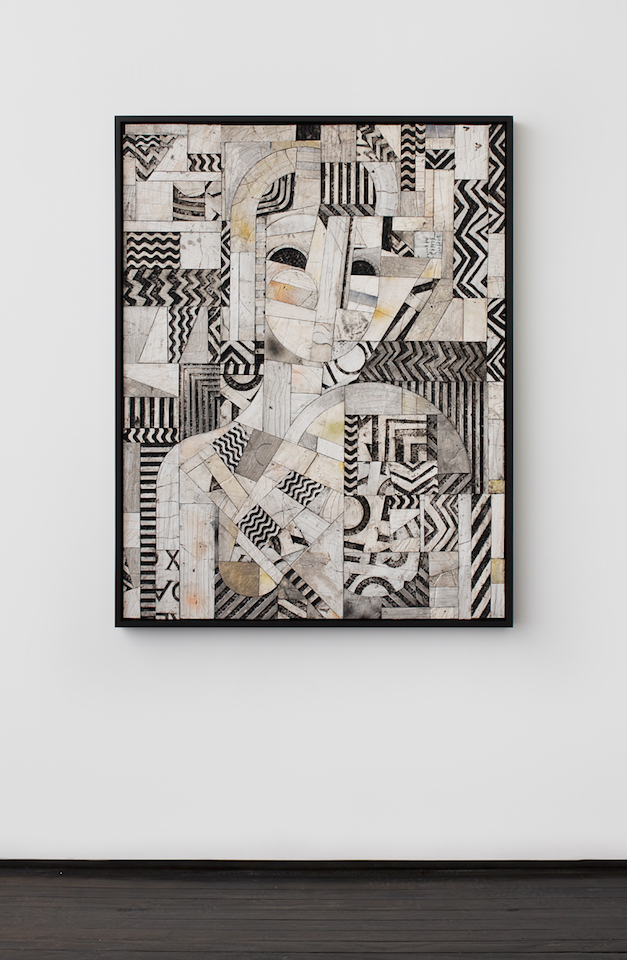
© » KADIST
Ruby Sky Stiler
The depiction of the female figure in the sculptures remains an economic, canny composition of geometric abstractions in a Modernist spirit. Yet rather than provide us with the layers of information found in her wall reliefs, the sculptures exclusively frame space. In place of the tactile surfaces that can be carved into and drawn on, the sculptures’ outlines provide multiple perspectives on to their surroundings, and additionally unto themselves.

© » KADIST
Alejandro Almanza Pereda
This still life falls apart, or rather floats apart as the composition is proved unstable and constantly morphing. An impossible attempt at achieving a fixed state, some objects remain buoyant and some objects sink, constantly tilting the overall scale and arrangement. Properties of weight, mass and shape have their own will but a hand appears in the scene, pushing back on these mysterious forces.

© » KADIST
Bontaro Dokuyama
In Over There, Bontaro Dokuyama conducted a series of workshops with various people who had been forced to relocate in temporary housing after the Fukushima accident. Participants in the workshop made masks from local newspaper cuttings, included in the installation as well as videos showing these different persons wearing their masks, pointing in the direction of their hometowns, where they can no longer return. Over There portrays those displaced from Fukushima due to the 2011 nuclear disaster, underlining the subjectivity of each person in opposition to the way they are usually considered within the Japanese society or by the media, calling them “victims from the disaster.”

© » KADIST
Gaëlle Choisne
Entre Chien et Loup is an installation incorporating a variety of media: rubber, discs, feathers and confetti that the artist weaves, sews and glues together. Influenced by Mike Kelley’s Memory Ware series, the artist creates an object-memory from found materials. The found objects used recall the artist’s mother – it is somehow her portrait, her cape-.

© » KADIST
Sahej Rahal
Drawing & Print (Drawing & Print)
Within the narrative of Sahej Rahal’s The rocks we will find, beings perform absurd acts in derelict corners of the city, emerging into the everyday as if from the cracks of our civilization, transforming them into liminal sites of ritual, and challenging ways in which we experience time and space. The temporal acts and their residue become primary motifs in his practice. The characters that inhabit these performances bare indices to different cultures, mythologies and pop culture.

© » KADIST
Bady Dalloul
Bady Dalloul’s Scrapbook is a 48 minute video beginning from his birth, tracing major global events of the 20 th century, including the beginning and current Occupation and colonization of Palestine, the atomic bombings of Hiroshima and Nagasaki, assassination of family members and the Syrian diaspora. A voice over follows these moments as the camera traces over the collage that includes text; photos; postcards; origami birds; and inserted videos of world leaders. The film is a letter to the viewer, imploring the witnessing of what we assume, but cannot know, to be the artist speaking.

© » KADIST
Aimée Zito Lema
Rond de Jambe by Aimée Zito Lema is a series formed by two works: a three-channel video installation and a live performance. Each component in this project approaches the same subject matter through a different medium in order to investigate politics as they are made manifest in and through the body. Using archival footage of protests of the Stopera building project in Amsterdam as a starting point, artist Aimée Zito Lema worked with dancers to translate the protest movements into a choreography.
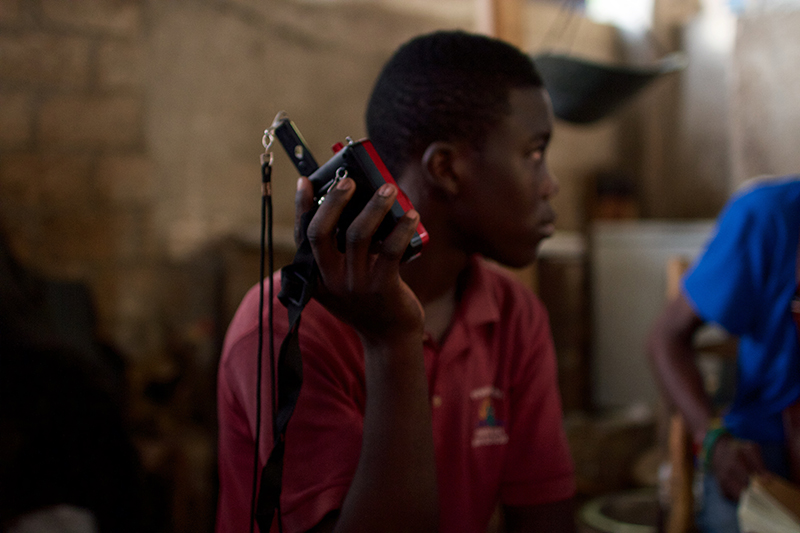
© » KADIST
Beatriz Santiago Muñoz
Marché Salomon by Beatriz Santiago Muñoz depicts two meat vendors, a young man and woman, chatting in Marché Salomon, a busy Port-au-Prince market. Amongst the surrounding bustle, the two have an unsentimental discussion about the mystical qualities of common products sold at the market, wondering whether the divine can inhabit any kind of object—mass produced bottles, toxic rivers, beheaded goats. Their musings weave together the cosmic and the mundane, with the work of butchering a goat and the characters of the market serving as existential metaphors for the universe, time travel, ghosts, and death.
Joanna Piotrowska
Photographer and filmmaker Joanna Piotrowska explores issues such as the female condition, family dynamics, and post-Soviet Poland, through black and white images that depict the quotidian...
Kaoru Arima
Kaoru Arima experiments with painting in order to discover new expressive forms...
siren eun young jung
With a practice deeply engaged with feminism and LGBT rights issues, siren eun young jung reveals the subversive power of traditional culture, one unknown in the Korean modernization period, and provides unique perspectives and documentation of important communities...
Toyin Ojih Odutola
Though born in Nigeria, artist Toyin Ojih Odutola was raised largely in the United States, living in Alabama, California, and now New York...
Hao Liang
The work of Hao Liang reimagines and explores the sublime of contemporary ecological landscapes...
Reyes Santiago Rojas
Reyes Santiago Rojas works with themes relates to nature, patience and garbage...
Claudia Joskowicz
Claudia Joskowicz is a video and installation artist working at the intersection of landscape, history, and memory...
Ian Wallace
- year born: 1943
- gender: male
- nationality: British
- home town: Shoreham, United Kingdom
Ho Rui An
The artist, writer, and researcher Ho Rui An probes histories of globalization and governance, performing a detournement of dominant semiotic systems across text, film, installation, and lecture...
Sara Cwynar
Cwyner is both related to a photo conceptual tradition of photography from Vancouver as well as to a new school of photography working with digital manipulation, scanners, stock photography and the notion of photography after image making, both of which are represented in the Kadist collection via artists such as Arabella Campbell, Ron Terada, Tim Lee, Rodney Graham, Ian Wallace from Vancouver and artists such as Chris Wiley, Lucas Blalock, Erin Shirreff or John Houck, who recently have explored the idea of photography beyond image making....
Elham Rokni
Born just after the Islamic Revolution, Elham Rokni (b...
Akira Takayama
Aki ra Takayama is a Japanese theat e r director known for creating projects that challenge the c onventional framework of theater ...
Danielle Dean
Danielle Dean creates videos that use appropriated language from archives of advertisements, political speeches, newscasts, and pop culture to create dialogues to investigate capitalism, post-colonialism, and patriarchy...
Otobong Nkanga
Visual artist and performer, Otobong Nkanga’s (b...
Bady Dalloul
Bady Dalloul cunningly employs collage across various media: texts, drawings, video, and objects to produce powerful works commenting on the past and the present...
Shimon Minamikawa
Since the beginning of his career, Minamikawa Shimon has made work that deviates from conventional painting and other formats...
Ruby Sky Stiler
Ruby Sky Stiler has established a visual language in which historical periods, art movements, and spatial dimensions readily coexist...
Adelita Husni-Bey
Born in Milan, Italian-Libyan Adelita Husni-Bey is an artist and researcher...
Bontaro Dokuyama
Bontaro Dokuyama became an artist after the triple disaster of March 2011 that irrevocably damaged his hometown of Fukushima, “sensing that everything that had been taught to him was a lie.” Previously working as an architect, he then started his artistic practice under a new name in order to underline the beginning of this new life...
Carolina Caycedo
Carolina Caycedo’s work triumphs environmental justice through demonstrations of resistance and solidarity...
Sarah Lai Cheuk Wah
Sarah Lai Cheuk Wah is best known for her paintings of common objects and urban landscapes, which she renders realistically in great detail...
Margo Wolowiec
Margo Wolowiec uses her multidisciplinary practice to examine space, material versus conceptual practices, and affective responses...
Adrian Melis Sosa
Adrian Melis’s work is committed to presenting the range of intensity and nuance of human energy embodied through acts of resistance, resilience, and productivity...
Mary Reid Kelley
Drawing from literature, plays, and historical events, Mary Reid Kelley makes rambunctious videos that explore the condition of women throughout history...
Zhu Jia
Pioneer of video art in China, Zhu Jia’s works have often dealt with ‘realness’ and everyday life, though often in unconventional ways...
Shahryar Nashat
The work of Shahryar Nashat (b...
Wu Tsang
Wu Tsang’s work is often framed in terms of her identity as a trans woman of color...
Ibro Hasanovic
Ibro Hasanovic is a film, video, photographic and installation artist currently based in Brussels, Belgium, concerned largely with the powers of individual and collective memory...


